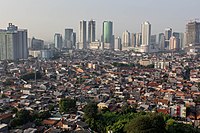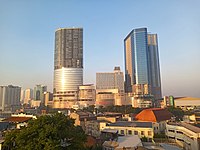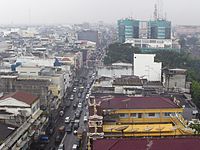List of metropolitan areas in Indonesia
The government of Indonesia defines a metropolitan area as an urban agglomeration where its spatial planning is prioritised due to its highly important influence on the country.[1] The metropolitan areas in Indonesia are managed based on Presidential Regulation (Peraturan Presiden). The national government has established 10 metropolitan areas across the country, anchored by the cities of Jakarta, Surabaya, Bandung, Semarang, Medan, Makassar, Palembang, Denpasar, Banjarmasin, and Manado. Despite having no official metropolitan areas recognised on national level, there are several cities whose urbanisation exceeds their city limits such as Yogyakarta, Malang, and Cirebon.
Official metropolitan areas[]
| Metropolitan area | Image | Official acronym | Regencies and cities | Area (km2) |
Estimated population |
Ref. |
|---|---|---|---|---|---|---|
| Jakarta metropolitan area | 
|
Jabodetabekpunjur |
|
7,062.47 | 33,430,285 | [3] |
| Surabaya metropolitan area | 
|
Gerbangkertosusila |
|
5,925.84 | 9,570,870 | [4] |
| Bandung metropolitan area | 
|
Bandung Basin |
|
3,411.35 | 8,357,393 | [5] |
| Semarang metropolitan area | 
|
Kedungsepur |
|
4,298.43 | 5,689,149 | [6] |
| Medan metropolitan area | 
|
Mebidangro |
|
3,146.62 | 4,601,565 | [7] |

|
Mamminasata |
|
2,667 | 2,621,168 | [8] | |
| Palembang metropolitan area | 
|
Patungraya Agung |
|
7,585.96 | 2,570,981 | [9] |

|
Sarbagita |
|
732.67 | 2,388,680 | [10] | |

|
Banjarbakula |
|
8,136.36 | 1,939,347 | [11] | |
| Manado metropolitan area | 
|
Bimindo |
|
1,379.26 | 830,137 | [12] |
Built-up urban areas[]
The followings are the contiguous urban areas in Indonesia, with a population of over one million, according to Demographia's "World Urban Areas" study. Demographia defines an urban area (urbanised area agglomeration or urban centre) as a continuously built up land mass of urban development that is within a labor market (metropolitan area), without regard for administrative boundaries (city).[13]
| Rank | Urban area | Area (km2) |
Estimated population |
Notes[13] |
|---|---|---|---|---|
| 1 | Jakarta | 3,540 | 34,540,000 | Jakarta's built-up urban area extends beyond its official metropolitan area, including Karawang. |
| 2 | Bandung | 487 | 7,065,000 | Although Surabaya metropolitan area has a larger population than Bandung metropolitan area, the former comprises more rural areas while the latter has more dense urban population. |
| 3 | Surabaya | 911 | 6,499,000 | |
| 4 | Medan | 478 | 3,632,000 | Medan is the largest urban area outside of Java island. |
| 5 | Semarang | 259 | 1,992,000 | Although Semarang metropolitan area is the fourth most populous in Indonesia, it actually comprises a significant portion of rural areas. Semarang's urban population is much smaller than Medan. |
| 6 | Makassar | 178 | 1,952,000 | Makassar is the largest urban area outside of Java and Sumatra. |
| 7 | Palembang | 221 | 1,889,000 | Palembang is the third largest urban area outside of Java island, after Medan and Makassar. |
| 8 | Yogyakarta | 230 | 1,568,000 | Although it has no metropolitan area recognised on national level, Yogyakarta has the eighth largest urban population in Indonesia, extending far beyond its small city proper area of 32.5 km2.[14] Nevertheless, the urban area, known locally as Kartamantul, is managed through Sekretariat Bersama Kartamantul with patronage of the provincial government. |
| 9 | Malang | 212 | 1,493,000 | Although it has no metropolitan area recognised on national level, Malang urban population extends far beyond its administrative area of 145 km2.[14] |
| 10 | Denpasar | 177 | 1,389,000 | Denpasar is the second largest urban area outside of Java and Sumatra, after Makassar. |
| 11 | Batam | 243 | 1,362,000 | As an island-city, Batam has not developed a metropolitan area with its surrounding regions, hence its urban population is entirely within its administrative area. |
| 12 | Pekanbaru | 239 | 1,118,000 | Pekanbaru has no metropolitan area recognised on national level, and its urban population is pretty much concentrating in its city proper. |
| 13 | Surakarta | 477 | 1,106,000 | Although it has no metropolitan area recognised on national level, Surakarta's urban population extends far beyond its administrative area of 46 km2.[14] |
| 14 | Cirebon | 105 | 1,017,000 | Although it has no metropolitan area recognised on national level, Cirebon's urban population extends beyond its administrative area of 37.4 km2.[14] |
See also[]
References[]
- ^ "Bulletin Electronik". Archived from the original on 2 October 2017.
- ^ (Cugenang, Pacet, Sukaresmi and Cipanas districts)
- ^ "PU-net". perkotaan.bpiw.pu.go.id.
- ^ "PU-net". perkotaan.bpiw.pu.go.id.
- ^ "PU-net". perkotaan.bpiw.pu.go.id.
- ^ "PU-net". perkotaan.bpiw.pu.go.id.
- ^ "PU-net". perkotaan.bpiw.pu.go.id.
- ^ "PU-net". perkotaan.bpiw.pu.go.id.
- ^ "PU-net". perkotaan.bpiw.pu.go.id.
- ^ "PU-net". perkotaan.bpiw.pu.go.id.
- ^ "PU-net". perkotaan.bpiw.pu.go.id.
- ^ "PU-net". perkotaan.bpiw.pu.go.id.
- ^ a b "Demographia World Urban Areas, 14th Annual Edition" (PDF). April 2019. Archived from the original (PDF) on 7 February 2020. Retrieved 9 February 2020.
- ^ a b c d "Indonesia: Administrative Division (Provinces, Regencies and Cities) - Population Statistics, Charts and Map". www.citypopulation.de.
External links[]
- Lists of cities in Asia
- Indonesia geography-related lists
- Lists of metropolitan areas in Asia Pacific
- Metropolitan areas of Indonesia
